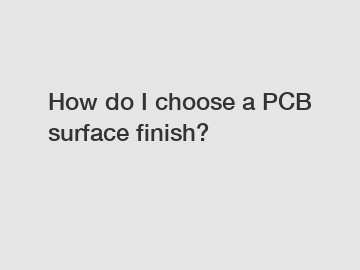How do I choose a PCB surface finish?
Mar. 25, 2024
Choosing the right PCB surface finish is a crucial decision when designing a circuit board. The surface finish serves as a protective layer that shields the copper traces on the PCB from external elements and ensures the longevity and reliability of the board. With various options available in the market, selecting the most suitable surface finish can be challenging. Factors such as cost, operating environment, and assembly process need to be considered when making this decision. In this article, we will discuss how to choose the right PCB surface finish that meets your requirements.
**Understanding Different Types of PCB Surface Finishes**.
Before selecting a surface finish, it is essential to understand the different types available and their characteristics:

- **Lead-free HASL (Hot Air Solder Leveling)**: Lead-free HASL is one of the most common and cost-effective surface finishes. It provides a flat surface for easy component placement and soldering. However, it is not suitable for fine pitch components due to its uneven surface.
- **ENIG (Electroless Nickel Immersion Gold)**: ENIG is a popular surface finish that offers excellent corrosion resistance and solderability. It is ideal for fine pitch components and provides a flat surface for smooth solder joints. However, ENIG is more expensive than HASL.
- **OSP (Organic Solderability Preservatives)**: OSP is a thin organic coating that protects the copper traces from oxidation. It is cost-effective and suitable for SMT assembly. However, OSP has limited shelf life and requires careful handling during assembly.
- **Immersion Silver**: Immersion silver provides good solderability and is suitable for RF applications due to its excellent conductivity. However, silver is prone to tarnishing, which can affect the reliability of the PCB.
**Factors to Consider When Choosing a PCB Surface Finish**.
1. **Operating Environment**: The operating environment of the PCB plays a significant role in determining the suitable surface finish. For example, if the PCB will be exposed to high temperatures or humidity, a surface finish with good thermal resistance and corrosion protection such as ENIG or gold plating would be ideal.
2. **Assembly Process**: The assembly process used for the PCB also influences the choice of surface finish. Some surface finishes are more compatible with specific assembly techniques such as reflow soldering or wave soldering. It is essential to consider the compatibility of the surface finish with the assembly process to ensure optimal solderability and reliability.
3. **Cost**: Cost is another crucial factor to consider when choosing a PCB surface finish. Some finishes such as ENIG and immersion gold are more expensive than traditional finishes like HASL or OSP. It is essential to balance cost with performance requirements to select the most cost-effective option for your application.
**Conclusion**.
Choosing the right PCB surface finish is a critical decision that impacts the performance and reliability of your circuit board. By considering factors such as operating environment, assembly process, and cost, you can select a surface finish that meets your requirements. Whether you opt for a cost-effective finish like HASL or a high-performance finish like ENIG, it is essential to choose a surface finish that ensures the longevity and reliability of your PCB.
For further assistance in choosing the right PCB surface finish, feel free to contact us.
If you are looking for more details, kindly visit immersion tin 4layer , immersion tin pcb , automotive pcb design .
340
0
0


Comments
All Comments (0)